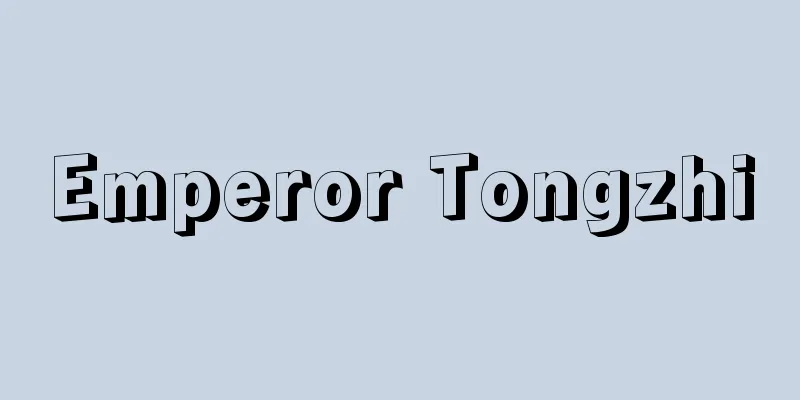Emperor Tongzhi

|
The 10th emperor of the Qing Dynasty of China (reigned 1861-75). His name was Zaichun. His posthumous name was Emperor Yi. His temple name was Muzong. He is known as the Tongzhi Emperor because of the era name. He was the eldest son of Emperor Xianfeng, and his birth mother was Ye Henara (Empress Dowager Cixi). He ascended to the throne at the age of 5 when Emperor Xianfeng died of illness in Jehol due to the invasion of Beijing by the British and French allied forces. However, Empress Dowager Cixi joined forces with Prince Gong Yiqin and executed the conservative foreign policy leader Sushun, seizing real power and controlling politics for nearly 50 years. The anti-Qing forces of the Taiping Heavenly Kingdom and Nian Army were suppressed in 1864 and 1868 respectively with the help of the Han Chinese bureaucrat Zeng Guofan and foreign powers. The emperor began ruling personally at the age of 19, but this period of relative stability was marked by a policy of foreign cooperation and was known as the "Restoration of Tongzhi". The Westernization Movement, centered around the Han Chinese bureaucrats, began to unfold, with the aim of absorbing modern Western science and enriching the country and strengthening its military, and reforms were made to the military, shipbuilding industry, and communications facilities. The emperor is said to have died of smallpox, but it is also said that he was killed by Empress Dowager Cixi, with whom he later became an enemy. [Yoshio Hosoya] Source: Shogakukan Encyclopedia Nipponica About Encyclopedia Nipponica Information | Legend |
|
中国、清(しん)朝第10代の皇帝(在位1861~75)。名は載淳。諡(おくりな)は毅(き)皇帝。廟号(びょうごう)は穆宗(ぼくそう)。年号によって同治帝とよばれる。咸豊(かんぽう)帝の長子で、生母は葉赫納喇(イエヘナラ)氏(西太后(せいたいこう))。咸豊帝がイギリス・フランス連合軍の北京(ペキン)侵入のため熱河(ねっか)で病没すると5歳で即位したが、西太后は恭親王奕訢(きょうしんおうえききん)と手を結び、対外保守派の粛順(しゅくじゅん)を処刑して実権を握り、以後50年近く政治を左右した。太平天国軍、捻(ねん)軍の反清勢力をそれぞれ1864年、68年に漢人官僚の曽国藩(そうこくはん)や外国勢力の力を借りて鎮圧した。19歳で帝は親政したが、満州人にかわって台頭した曽国藩、李鴻章(りこうしょう)らの漢人官僚の力と、対外国協調政策とによって相対的に安定した時期で、「同治中興」と称される。漢人官僚を中心として西洋近代科学を吸収し富国強兵を図ろうとする洋務運動が展開され始め、軍事、造船工業、通信設備などが改革された。帝は天然痘で病没したとされるが、のちに対立した西太后の手にかかったともいう。 [細谷良夫] 出典 小学館 日本大百科全書(ニッポニカ)日本大百科全書(ニッポニカ)について 情報 | 凡例 |
<<: Two Treatises of Government
>>: Act of government - Touchikoi (English spelling) Regierungsakt; acte de gouvernement
Recommend
Kojiki and Nihonshoki myths
According to Ishimoda Tadashi, these heroic myths...
Rossi - Giovanni Vittorio Rossi
Date of birth and death unknown. Italian ballet t...
Caspe Conference - Caspe Conference
…He preached against heresy in France and Italy, ...
North Sea Oil and Gas Fields - Hokkaiyu Gas Fields
The discovery of the Groningen gas field in the Ne...
Shimazu Sadahisa
Year of death: Joji 2/Shohei 18.7.3 (1363.8.12) Ye...
Syncytium
...the cell membrane of two or more adjacent cell...
Musashi song - Musashiburi
A collection of haiku poems. Compiled by Ohara Chi...
musique mesurée à l'antique (English spelling)musique mesureealantique
...The leader of this group, Ronsard, repeatedly ...
Yoshihiro Inayama
Manager. Born in Tokyo. Graduated from the Depart...
transaction
...In the narrow sense, a business transaction re...
Rock shelter art (English) rockshelterart
…The carvings were made with stone or metal tools...
Chukchi-Kamchatkan language family - Chukchi-Kamchatkan
It is found in the northeastern corner of Asia, ad...
Athanas kominatoensis (English spelling) Athanaskominatoensis
...The eggs are opaque and small, making them uns...
Monkey business
…The marginal decorations are also very secular. ...
Cone pepper
…var. cerasiforme (cherry pepper) is a variety cu...









